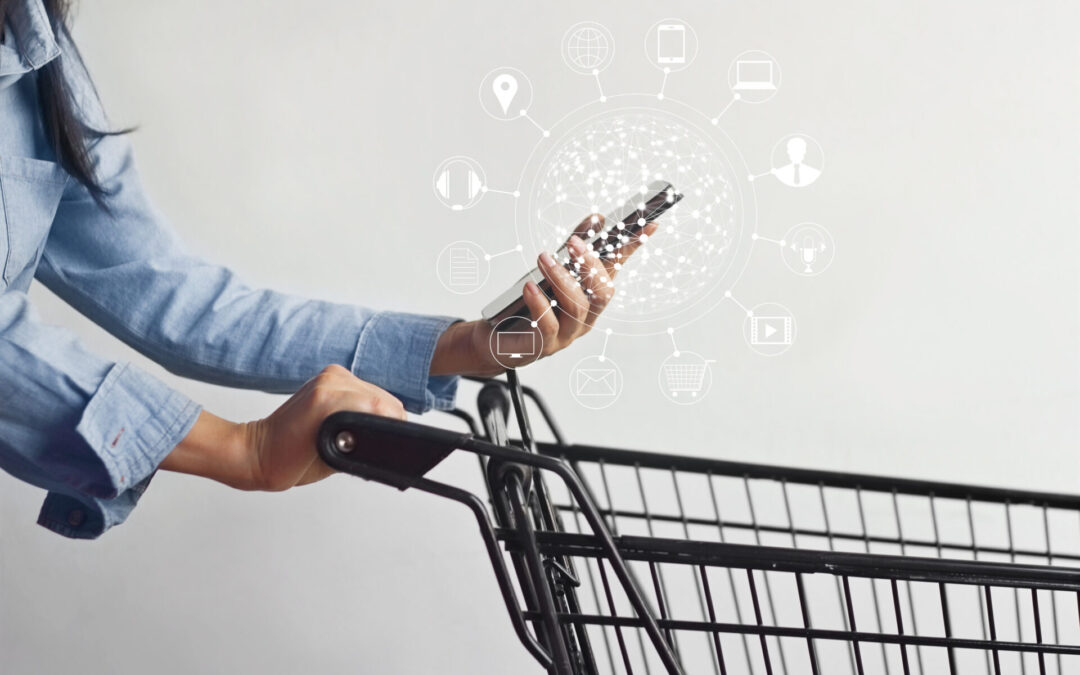Do you prefer shopping in person or online? Depending on what you’re buying, each method has pros and cons. While e-commerce is convenient for items like office supplies, it can lead to issues with products like mattresses and clothes that you can’t thoroughly assess without experiencing them in person.
While online shopping has enjoyed growing popularity, a surge in traffic at physical stores as pandemic restrictions eased shows that many consumers still value in-person experiences before buying. In 2023 and beyond, industry experts foresee a world where successful retailers blend the convenience of online shopping with unique in-store events and features to take customer experiences to the next level.
The Surge and Slowdown of E-commerce Sales Growth
During the first year of the pandemic, online sales shot up while people stayed home. E-commerce went from accounting for 11.1 percent of total sales in the fourth quarter of 2019 to 16.4 percent of all sales by Q2 2020, according to U.S. Census Bureau data published by FRED, the Federal Reserve Bank of St. Louis. However, as lockdowns eased, e-commerce sales growth slowed, dropping to 14.3 percent of total sales by Q1 2022. As of Q3 2022, that figure was 14.8 percent, still below its early pandemic high.
In 2021, U.S.-based retailers announced the openings of over 8,100 new stores, compared to just 3,950 closings, an analysis conducted by The Daily on Retail found, as reported by the National Retail Federation. Notably, “digital natives” such as Warby Parker, Vuori, and Fabletics publicized plans to establish new brick-and-mortar stores.
Combining Online and Offline Retail to Create a Continuous Experience
As we mentioned in last month’s blog entry on commercial real estate trends to watch this year, PwC’s 2023 Emerging Trends in Real Estate report predicts that in-person shopping will have the chance to make a comeback while online spending experiences slower growth. The report quotes an investment consultant saying that successful sellers will “bridge the gap between e-commerce and bricks and sticks.”
Similarly, Shopify notes in a 2023 report on retail trends that in-person and online shopping “are no longer separate lanes of business.” With three-quarters of customers investigating items online before buying either in-person or via the internet, “omnichannel” retail that blends online and offline shopping into one continuous customer experience is emerging as the way of the future.
Salesforce defines omnichannel retail as “a model in which clients are able to interact with multiple sales and media channels at once, and have their information retained by the retailer as they move between them.” For instance, you might browse products online and then visit a physical store to make a final purchase as part of a consistent experience.
Factors Driving the Rise of Omnichannel Retail
Industry experts expect standout retailers to embrace a strategy combining brick-and-mortar stores and online shopping for numerous reasons. Here are some of the key factors fueling the rise of omnichannel retail.
- It gives customers more flexibility.
Salesforce notes that omnichannel shopping is more “customer-centric,” allowing people to choose how, when, and where they browse products, compare prices, and make purchases. - Many people still prefer to shop in person.
Nearly half (48 percent) of consumers prefer to shop in person when given the option, according to a 2021 press release on the State of the In-Store Experience Report from Raydiant. Offering online shopping and maintaining physical stores ensures that prospective customers can shop via the channel of their choice. - Physical stores drive traffic to retailer websites.
There is a “direct and positive correlation between having both a physical and a digital presence,” Tom McGee, president and CEO of the International Council of Shopping Centers (ICSC), said in a press release. An ICSC study titled “The Halo Effect: How Bricks Impact Clicks” found that opening a physical store results in a 37 percent increase in overall website traffic on average for retailers. - Technology has created opportunities for unique in-store experiences.
Brands have begun leveraging emerging tech to offer in-store experiences that customers can’t get anywhere else. For example, Nike Style stores feature QR codes that allow shoppers to access augmented reality, according to Business Insider. - Buying at a brick-and-mortar store appeals to eco-conscious customers.
Purchasing a product online often means that it must be delivered in a large amount of protective packaging. People looking to reduce waste might prefer to buy items in brick-and-mortar stores and forgo the extra boxes and padding.
If you’re interested in boosting business by opening a new store, the Avalon Realty Associates team can help you find Chicago commercial retail space for lease. Our team can also help you find commercial properties in other areas, including Glenview, Rolling Meadows, Orland Park, Buffalo Grove, Arlington Heights, Northbrook, Naperville, Glendale Heights, Gurnee, Hawthorn Woods, and more.
Visit our contact us page, call us at 847-506-1000 or email info@avalonreal.com for information about our commercial real estate services.

